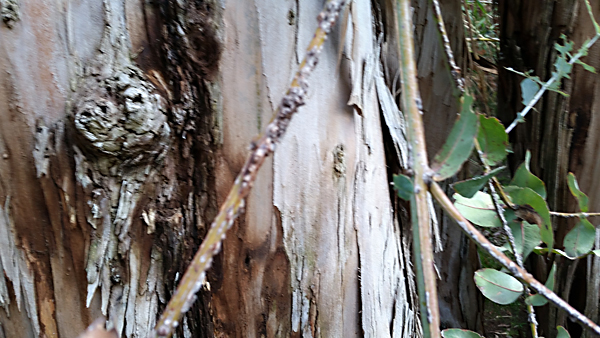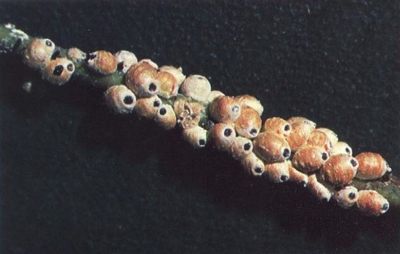
Recently, on a routine technical Mauget service call to see what was effecting a homeowners Eucalyptus tree. Ann Hope, Maugets technical field representative was surprised to observe scale insects on a Eucalyptus globulas tree. A tree not known to have scale issues in the U.S..
On futher researching, found a great article from Austrailer on the subject.
Mauget feels that it may be important to focus on this issue.
Mauget has several products that should handle this if it becomes a widespread problem including Dinocide, Imicide and others products.
See Mauget Insecticide Products:
The informative article reads as follows:
Eriococcus coriaceus (Gum-tree scale) in New Zealand
Insect:
Eriococcus coriaceus Maskell (Hemiptera: Coccoidea: Eriococcidae)
 .
.
Sacs of adult females of the gum-tree scale on a twig of Eucalyptus globulus.
The sacs are 2-4 mm long.
Type of injury
This scale insect sucks the sap of eucalypts and may cause dieback of branches; occasionally a
severe attack can kill the tree. Photosynthesis may be affected when leaves are covered with
sooty mould growing on the honeydew excreted by the insects.
Hosts
Only eucalypts are attacked, and trees of the blue-gum group are the most susceptible. In New
Zealand the scale is found on Eucalyptus amygdalina, E. eugenioides, E. globulus, E. gunnii, E.
macarthurii, E. nitens, E. obliqua, E. regnans, E. viminalis, and a few others including ornamentals such
as E. cinerea.
Distribution
This Australian insect is well-established throughout New Zealand.
The effect on trees is usually overshadowed by that of the
leaf-eating insect Paropsis charybdis (eucalyptus tortoise beetle).
Description, life history, and habits
Each adult female is enclosed in a rounded felted sac, 2-4 mm long and varying in colour from
yellowish to dark brown. Each sac is attached by its underside to the host and has an opening at
the top which is blocked by the rear of the insect’s abdomen. The sacs (Fig. 1) are often packed
so close together that stems and twigs may be entirely covered for several centimetres; individual
sacs may occur on the veins of leaves. The adult female is brown and usually about 1.7 mm long,
but some can reach 3.5 mm in length. Like all female scale insects, it is wingless. The legs,
antennae, and fine stylet mouth-parts are difficult to see even with a hand lens. If the insect is
squashed, a purplish liquid oozes out. Several hundred eggs are laid by a single female inside the
sac; the bigger the female the greater the number of eggs. After hatching from the eggs, the red
nymphs or “crawlers” emerge through the opening at the top of the sac, move over the surface of
the tree, and are often scattered by wind for long distances. A crawler remaining on the tree or
reaching another suitable host, settles down on the leaves or small twigs, inserts its stylet, and
starts sucking sap. The crawler also secretes wax threads to form the sac under which it lives.
The sex of these first-stage nymphs cannot be recognised. After moulting each crawler moves
out from its sac and settles elsewhere on the host.
The sacs of the second-stage males are elongate, white, and papery and are often made under
loose bark or in crevices. Except for a slit at the rear, each sac encloses the whole body. The
males pupate under the sacs and emerge as winged adults. These are 1.4 mm in length, have
relatively long legs and antennae, and a pair of rather large, broad, transparent wings. Two white
waxy filaments projecting backwards from the abdomen are formed while the male is in the sac,
but usually break off during emergence. The males have no mouth-parts and live for only 2-3
days. Their sole function is the fertilisation of the adult females and one male may mate with
several females.
The second-stage female crawler grows under its waxy secretion and doubles its size in about
12-15 days. It moults, emerges from its protective covering, moves along the twigs to a new
position, and inserts its mouth-parts. It usually stays in this spot, but if the place is unsuitable for
feeding it withdraws its stylet and tries elsewhere. A few days after the insect settles down, the
felted sac gradually appears and is usually completed within a fortnight. In this time the female
grows to full size and is fertilised. Females mate only once. Eggs are laid in the sac four weeks after
the final moult. Unfertilised females do not produce progeny.
In New Zealand the number of generations which the gum-tree scale has in one year is unknown,
but in South Australia there are at least four generations a year and all stages can be found at any
time. In warm weather the life cycle can be completed in about 50 days; in cold weather it may
take up to three months (Patel 1971).
The insects suck up more sap than they can use. Excess sugars are discharged as very fine
droplets of a sweet sticky substance, called honeydew. This fails onto lower parts of the host tree
and soon becomes covered by a sooty mould which gives severely attacked plants a blackish
appearance. The sooty mould decreases the amount of light reaching lower leaves and
presumably reduces their contribution to the total photosynthetic activity of the tree.

